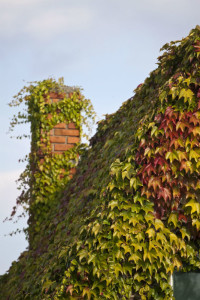You may enjoy the ivy that creeps up your chimney, softening the look of your home and providing a romantic, old-world feel. Or perhaps you’re ambivalent to the ivy that has made its way up your chimney. Regardless of how you feel about your ivy, you should be aware of the danger it causes to your home.
How ivy causes damage
Initially, ivy can be harmless, but over time, its roots can make its way into small cracks in your home’s masonry, siding, or woodwork. As the plant and its roots grow, it can make those cracks larger and weaken the integrity of your home’s walls or chimney. Ivy can be especially damaging to homes that were built before 1930. Many of those homes were constructed with lime-based mortar, rather than the concrete-based mortar used today. The older mortar is softer and more susceptible to cracks and increased damaged from ivy.
How to deal with ivy
If you’re concerned that the ivy making its way up your chimney is damaging the structure, you should seek professional help. If the ivy truly has embedded itself in the bricks and mortar of your chimney’s structure, pulling the ivy away could cause the chunks or mortar and brick to come down with it. If you do remove your ivy, your chimney should be inspected by a professional chimney technician to ensure that its structure hasn’t been compromised. Cracks caused by ivy could lead to water leaks and foundation failure. Your chimney’s mortar could need to be repaired with tuck pointing, or some bricks may need to be replaced.
How to prevent ivy problems
If you like the look of ivy, you don’t have to give it up entirely. Some types of structures are suited to ivy growth. If you have a newly constructed brick wall or chimney without cracks, ivy can safely climb its sides. Ivy is not suited, however, to cracked masonry, older masonry, dry-stacked stone, wooden walls, siding, stucco, or painted surfaces. All of those surfaces could badly be damaged by ivy growth.
At the same time, some types of ivy are less invasive and have weaker roots that aren’t as damaging. English ivy has traditionally been used in landscaping and to creep up older buildings, but it now is classified as an invasive plant and has been banned in some states and communities. Structure-friendly types of ivy include Boston ivy and Virginia creeper, both of which have aerial roots that won’t make their way into cracks and cause further damage.
You also can consider other climbing plants, such as roses, clematis, wisteria, and jasmine, which will make their way up wooden or metal supports against your home to provide you with the soft, romantic look of ivy without the damage.
What to do if the damage has been done
If you suspect ivy already has damaged your chimney’s masonry, call the experts at Pristine Sweeps. Our chimney and masonry experts can inspect your chimney’s masonry for damage and perform any needed repairs.

